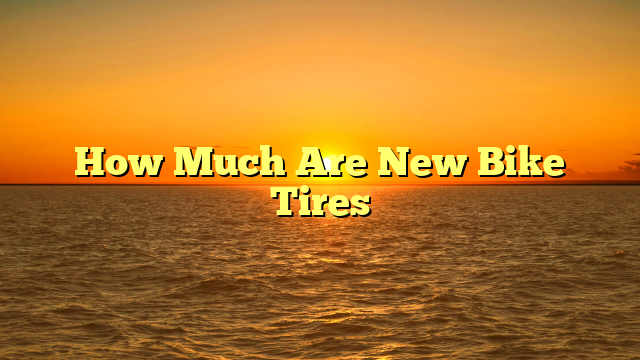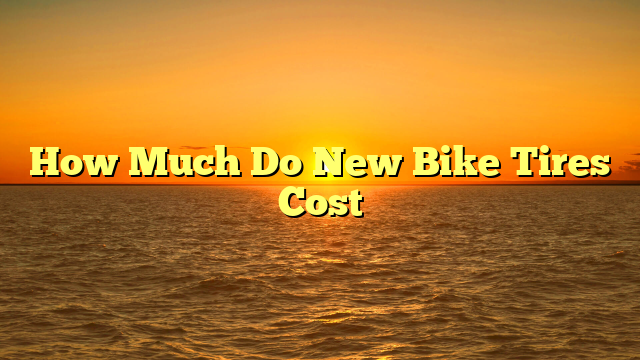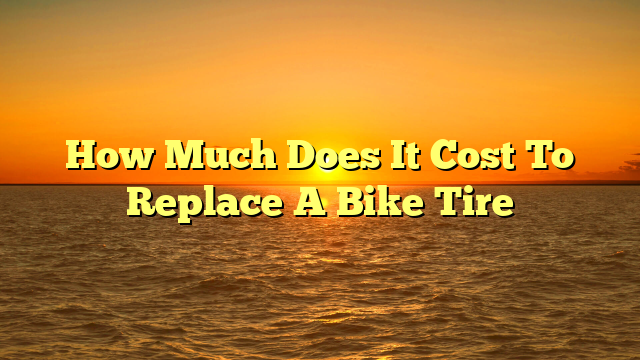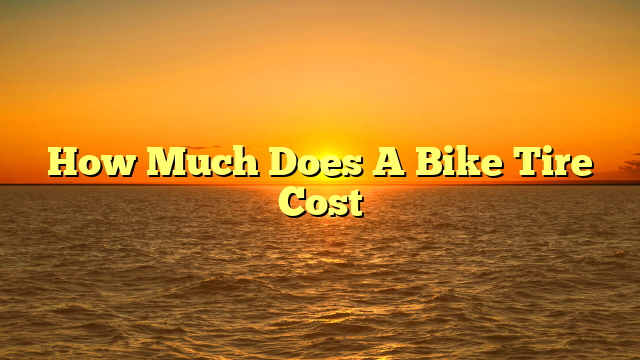As an avid cyclist, one of the most important maintenance tasks for my bike is replacing the tires when they wear out.
However, I’ve found that the cost of new bike tires can vary widely depending on several factors.
In this article, I’ll break down the different types of bike tires and their associated costs, as well as share some tips for saving money on this essential purchase.
Firstly, it’s important to understand that there are various types of bike tires, each designed for a specific type of riding.
Road bike tires, for example, are narrow and smooth to reduce rolling resistance on paved surfaces.
Mountain bike tires, on the other hand, are wider and have a more aggressive tread pattern to provide traction on rough terrain.
Hybrid bike tires are a combination of the two, with a slightly wider profile for stability and a tread pattern for versatility.
Each type of tire comes with a different price tag, so it’s crucial to choose the right one for your needs and budget.
Table of Contents
- 1 Key Takeaways
- 2 Types of Bike Tires and Their Cost
- 3 The Impact of Tire Size on Price
- 4 Premium vs. Budget Brands
- 5 Road Bike Tires
- 6 Mountain Bike Tires
- 7 Hybrid Bike Tires
- 8 Factors That Affect Tire Lifespan
- 9 Tips for Saving Money on New Bike Tires
- 10 Frequently Asked Questions
- 10.1 How do I know when it’s time to replace my bike tires?
- 10.2 Can I use any brand of tire on my bike, or do I need to stick to the same brand as my bike?
- 10.3 Are there any eco-friendly bike tire options available?
- 10.4 How do I choose the right tire tread for my riding style?
- 10.5 Is it worth investing in tubeless tires for my bike?
- 11 Conclusion
Key Takeaways
- The cost of new bike tires is influenced by several factors including the type of tire, tubeless vs.
traditional, tread pattern and complexity, size of tire, and brand reputation and quality.
- Tire performance is affected by recommended tire pressure, tread pattern for specific terrain, and the quality of rubber compound and casing thickness.
- To maintain the lifespan of bike tires, it’s important to regularly clean and inflate them, replace them before they become too worn down, and consider the impact of climate and weather conditions.
- Factors not included in this article include tire lifespan, tips for saving money on new tires, DIY tire repair, environmental factors, and quality of materials.
Types of Bike Tires and Their Cost
You’re gonna want to check out the different types of bike tires and their cost before making a purchase.
One of the main differences between bike tires is whether they are tube or tubeless.
Tube tires have a rubber inner tube that holds the air, while tubeless tires use a sealant to keep air in.
Tubeless tires tend to be a bit more expensive, but they offer better traction and can run at lower pressures, making them ideal for mountain biking or other off-road activities.
Another consideration when choosing a bike tire is the tread pattern.
Different tread patterns are designed for different types of terrain, and the cost can vary depending on the complexity of the pattern.
For example, a smooth tread pattern is good for riding on pavement, while a knobby pattern is better suited for off-road use.
More advanced patterns, such as those found on high-end racing tires, can be quite expensive.
Ultimately, the type of tire you choose will depend on your specific needs and budget, so it’s important to do your research and find the best option for you.
The Impact of Tire Size on Price
If you want to save money when buying new bike tires, it’s important to consider the impact of tire size on price.
The larger the tire, the more material is required to produce it, which often translates to a higher cost.
Additionally, larger tires typically come with more complex tire construction, which can also increase the price.
However, it’s important to note that the brand reputation also plays a significant role in the price of bike tires.
Well-known and reputable brands often charge a premium for their products, regardless of size.
So while smaller tires may be less expensive, purchasing from a less reputable brand may result in lower quality and durability in the long run.
Ultimately, it’s important to balance the impact of size on price with the overall quality and reputation of the brand when making a purchasing decision.
Premium vs. Budget Brands
When shopping for bike tires, it’s crucial to consider whether premium or budget brands will better suit your needs and preferences.
Here’s a quick rundown of the differences between the two:
- Quality: Premium brands tend to use higher-quality materials and have stricter quality control measures in place.
This means they often last longer and perform better than budget brands.
- Durability comparison: Budget brands may be cheaper upfront, but they often wear out faster and need to be replaced more often than premium brands.
This can end up costing you more in the long run.
- Performance analysis: Premium brands are often designed for specific types of riding, such as road racing or mountain biking, and can offer better performance in those areas.
Budget brands may be more general-purpose, but they may not perform as well in specialized situations.
- Cost: Premium brands are generally more expensive than budget brands, but they often offer better value in terms of performance and durability.
Overall, when choosing between premium and budget bike tires, it’s important to weigh the upfront cost against the long-term benefits.
While budget brands may seem like a good deal at first, they may end up costing you more in the long run due to their shorter lifespan and lower performance.
On the other hand, premium brands may have a higher upfront cost, but they often offer better value in terms of performance, durability, and overall enjoyment of your ride.
Road Bike Tires
Get ready to hit the road with some high-quality, durable tires that will enhance your riding experience.
When it comes to road bike tires, there are a few factors to consider in order to find the best option for your needs.
One of the most important considerations is tire pressure.
It’s essential to keep your tires inflated to the correct pressure for optimal performance and safety.
Generally, road bike tires require a higher pressure than other types of bike tires, typically ranging from 80 to 130 psi.
Be sure to check the recommended pressure for your specific tires and adjust as necessary.
Another important factor to consider when choosing road bike tires is the tread pattern.
The tread pattern affects how the tire grips the road surface, which is especially important when cornering or riding in wet conditions.
Slick tires have smooth, uninterrupted surfaces and are ideal for road riding in dry conditions.
However, if you plan on riding in wet or slippery conditions, look for tires with grooves or patterns that provide more traction.
Ultimately, the right tire choice will depend on your individual riding style and preferences.
Use the table below to compare some top-rated road bike tire options and find the perfect fit for your needs.
| Brand | Model | Tread Pattern | Max PSI |
|---|---|---|---|
| Continental | Grand Prix 5000 | Slick | 120 |
| Schwalbe | Pro One | Slick | 130 |
| Vittoria | Corsa Control | Grooved | 120 |
| Michelin | Power Competition | Slick | 123 |
As you can see from the table, there are a variety of options available when it comes to road bike tires.
Take the time to research and compare different brands and models, and consider factors such as tire pressure and tread pattern to find the best fit for your needs.
With the right tires, you can enjoy a smoother, more comfortable ride and tackle any road conditions with confidence.
Mountain Bike Tires
Ready to hit the trails with some top-notch MTB rubber?
Mountain bike tires are a crucial component of your ride, providing the necessary grip and traction for all types of terrain.
When it comes to tread patterns, there are many options to choose from.
The most common tread patterns are knobbed, which are designed for loose terrain, and smooth, which are better for hard-packed trails.
Some tires even have a combination of both.
Another important factor to consider is durability.
Comparing mountain bike tires, it’s important to look at the quality of the rubber compound and the thickness of the casing.
A thicker casing will provide more protection against punctures and cuts, but it will also add weight to your bike.
Additionally, the type of tire you choose can affect the durability.
Tubeless tires are becoming more popular as they offer a few advantages over traditional tubed tires.
They are less likely to puncture, and they also run at lower pressures, which can provide better traction.
However, they can be more difficult to install and maintain.
Ultimately, the choice between tubeless and tubed tires comes down to personal preference and the type of riding you will be doing.
Hybrid Bike Tires
To optimize my hybrid bike’s performance, I always consider the tire’s tread patterns and the thickness of the casing.
The right balance between durability and weight is crucial for a smooth ride.
There are many bike tire brands available in the market, and each one offers a different set of features.
Some of the popular brands include Schwalbe, Continental, and Maxxis.
Before selecting the tire, I also make sure to check the recommended tire pressure guidelines for my bike.
It’s essential to maintain the recommended pressure to avoid any punctures or damage to the tire.
The recommended tire pressure is usually listed on the sidewall of the tire or in the bike’s owner’s manual.
With the right tire and proper maintenance, I can enjoy a comfortable and efficient ride on my hybrid bike.
Factors That Affect Tire Lifespan
One important aspect to consider when selecting tires is understanding the factors that can impact their lifespan.
The following are some of the key factors that can have an effect on the longevity of your bike tires:
- Wear patterns: The way you use your bike can play a big role in how quickly your tires wear down.
For example, if you frequently ride on rough terrain with loose gravel or sharp rocks, your tires will wear down faster than if you mainly ride on smooth pavement.
Additionally, if you tend to corner hard or brake aggressively, this can also cause your tires to wear more quickly.
- Maintenance practices: Proper maintenance can help extend the life of your bike tires.
Regularly cleaning your tires can help prevent debris from causing damage, while keeping them properly inflated can help prevent premature wear.
Additionally, replacing your tires before they become too worn down can help prevent damage to your bike’s rims, which can be costly to repair.
- Environmental factors: The climate and weather conditions in your area can also impact your tire’s lifespan.
For example, if you frequently ride in wet conditions, your tires may wear down more quickly due to increased friction.
Additionally, exposure to UV rays can cause your tires to dry out and crack over time.
- Quality of materials: Finally, the quality of the materials used in your bike tires can also play a role in their lifespan.
Higher-quality materials may be more durable and resistant to wear, while lower-quality materials may degrade more quickly over time.
Tips for Saving Money on New Bike Tires
Now that we’ve discussed the factors that affect tire lifespan, let’s talk about how we can save money on new bike tires.
As a cyclist, I know that buying new tires can be costly and can sometimes put a dent in our budget.
However, there are ways to reduce the cost of purchasing new bike tires.
One of the ways to save money on new bike tires is by buying used ones.
With a bit of research and patience, we can find used tires that are still in good condition.
It’s important to inspect the tires carefully before purchasing and make sure there are no major defects or damages.
Another way to save money is by doing DIY tire repair.
Simple repairs such as patching a puncture or replacing a worn-out tube can be done at home with the right tools and knowledge.
By doing so, we can extend the life of our tires and avoid having to replace them too soon.
Frequently Asked Questions
How do I know when it’s time to replace my bike tires?
I replace my bike tires when the treads are worn down and there are visible signs of damage, such as cuts or punctures.
It is recommended to replace tires every 2-3 years, or sooner if you ride frequently.
Can I use any brand of tire on my bike, or do I need to stick to the same brand as my bike?
I can use any brand of tire on my bike, as long as it is compatible with my bike’s wheel size and type.
However, there may be performance differences between different brands.
Are there any eco-friendly bike tire options available?
I’ve researched eco-friendly bike tire options and found that some companies offer tires made from recycled materials or natural rubber.
These options address sustainability concerns and are a great choice for environmentally conscious cyclists.
How do I choose the right tire tread for my riding style?
When choosing tire tread for mountain biking, look for wider, deeper lugs for better grip on loose terrain.
For road cycling, opt for smoother treads with minimal rolling resistance.
Consider the terrain and weather conditions of your usual routes.
Is it worth investing in tubeless tires for my bike?
When comparing Tubeless vs.
Traditional tires, it’s worth investing in tubeless tires for their performance benefits.
They offer better traction, reduced punctures, and smoother rides.
The cost comparison may vary, but the long-term benefits make it a worthwhile investment.
Conclusion
Overall, the cost of new bike tires can vary greatly depending on several factors.
The type of bike you have and the size of the tires needed will greatly impact the price you can expect to pay.
Additionally, choosing between premium and budget brands can also play a role in how much you spend.
However, it’s important to keep in mind that the cost of new tires is a worthwhile investment in the safety and performance of your bike.
By taking proper care of your tires and regularly replacing them when necessary, you can extend their lifespan and save money in the long run.
And with these tips for saving money on new bike tires, you can find the perfect fit for your bike without breaking the bank.






![How Long Do Bikes Last? [Durability and Lifespan] How Long Do Bikes Last [Durability and Lifespan]](https://www.ridefoster.com/wp-content/uploads/2023/05/How-Long-Do-Bikes-Last-Durability-and-Lifespan.webp)
